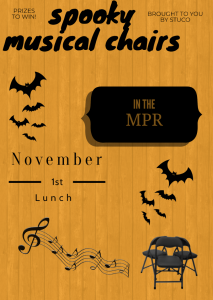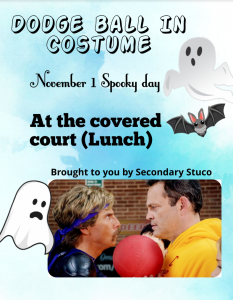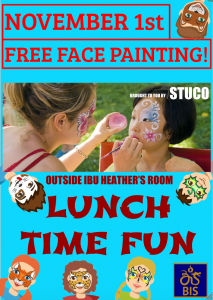Secondary Newsletter 13 – October 25, 2019
Principal’s Message
MYP Assessment Presentation
Grade 12 Theatre Invitation
Halloween
Teacher-Librarian Collaboration
CAS Corner
Budding archaeologists
Counselor’s Corner
Dear Parents,
It was wonderful to have an afternoon of Indonesian culture on Thursday when all Secondary students and staff participated in a Batik workshop. There are some student reflections on this event included in this newsletter. This is the first of six planned Indonesian cultural afternoons which will take place in our MYP/DP Hour time this school year.
Our ISSAC Football teams left this morning for the tournament in Bandung. Please follow their progress on Instagram @baliislandschool. We have empowered a group of motivated and tech savvy students with the BIS social media accounts to help us to improve our promotion of the school and increase the reach our posts have. Please support this by following and sharing/reposting BIS posts which will be coming regularly from our students.
We continue to focus on self-management as a skill for success and our students are being reminded to lock their belongings in the lockers and not leave things on top of lockers or tables which becomes untidy very quickly. Many students are still not using a padlock so please provide your child with one to lock their things safely away.
Ross Ferris
MYP Assessment Presentation – October 30
1:45-2:45, Library upstairs
There will be a presentation on MYP assessment.
Agenda:
- Making sense of the rubric based model
- The 4 objectives used for each subject and how the achievement level out of 8 is converted into a final grade of 7.
- The importance of command terms
- BIS Assessment Policy
- Parent activity
GRADE 12 DP THEATRE INVITATION
Dear Parents,
We are the Grade 12 Theatre group and we would like to invite you to watch our devised piece for our final collaborative project. One of the key components of our collaborative project is inviting our target audience to watch the performance. Therefore, as our targeted audience are parents, we are inviting you to watch our performance on Monday, October 28, 2019, starting from 3pm – 3:30pm. 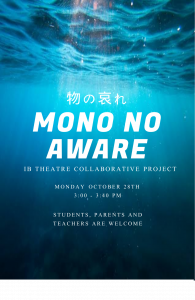
We would really appreciate as many parents to come as it is important for us to receive anonymous feedback on our performance, to then write about in our final submitted portfolio.
If you have any questions or concerns, please do not hesitate to contact Natasha Klee (nklee20@baliis.net).
Thank you in advance for your time and consideration.
Best wishes,
Grade 12 DP Students
Halloween 
Spooky day is coming up!
Make sure to get your costumes ready. The costumes does not have to look spooky. Don’t make it gory (no blood, flesh) as we still want to look school appropriate. We will choose the best dressed homeroom and you’ll get a prize. No themes are required but all homeroom members have to dress up in order to win the prize! We are going to have fun, existing activities during lunchtime and after school. Your options are either go to the party or leave the campus. These two events involves Primary students as well, so please make sure to be respectful.
How teacher – librarian collaboration works
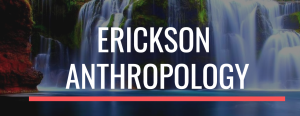 Just one of many subject-specific resource collections for BIS students how on the BIS Library Resources website
Just one of many subject-specific resource collections for BIS students how on the BIS Library Resources website
It occurred to me that a collaboration between myself and Grade 7 Individuals and Societies teacher Mrs. Anna Erickson may be of interest to those who, while using a school library from time to time, are not fully aware of what type of responsibilities or duties the job entails outside of managing and administering the library or teaching classes to Primary students.
Mrs. Erickson informed me of an assessment her students are beginning; an exploration into the 4 branches of anthropology (cultural anthropology, biological anthropology, linguistics and archeology). While she explained that the students will be directing and engaging in their own research on specific, nuanced subjects within these 4 “sub-disciplines”, they were in need of some broad, wide background information sources to give them an essential understanding of the overall topic and the landscape their further research would rest upon.
She called upon me to aggregate and coalesce these sources for the students to use before getting deeper into the topic on their own. So, mostly using our school database subscriptions and supplementing those sources with some other open-Internet resource websites (professional associations, government collections, digitized museum holdings, e-books, research organizations, publishers, etc.) and recommendations from the online library community, I was able to be together a deep but also succinct collection of resources that were at varying reading levels as well as formats (videos, articles, primary source pictures, diagrams).
The resources collected can’t simply be a large collection of the first web resources or links found; this can be overwhelming for students or turn them off if the first few they decide to use offer no credible help. It has to be a deft process of deciding which sources to use, how many to include, what to get rid of and even what order to put them in on the website. I have to respect the students’ needs and styles while also making sure they get the info they need but also leaving plenty of room to find the fresh information on their own.
The next step will be to conference with the students individually and create more personalized research searches (led by them) with my assistance and building on the background info they have hopefully obtained from the sources I put together. As students get older, this first step that I have set up for them will be replaced by their own beginning research, but for Grade 7, this is an acceptable compromise to make sure their path starts off correct.
The resource page is here.
Mr. Marshall
Librarian
PS – Don’t forget to follow the BIS Library on Instagram – @baliislibrary
Grade 7 are budding archaeologists! 
If you have talked with the Grade 7 in the last few weeks then you will have heard about our term 1 archaeology unit. We had a great time exploring what an archaeologist is and what they do. We also studied the philosophical challenges and limitations that archaeologists face when determining an artifact’s purpose and value as well as its broader contextual place in whatever culture is being studied through a dig.
Another aspect of archaeology we explored were 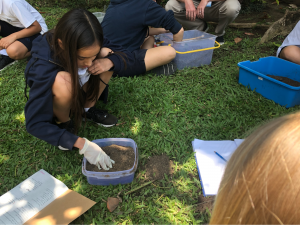 the physical challenges that are faced when it comes to the artifacts and evidence found in the digs. To experience this challenge first hand, we created our own mini dig, burying various organic and inorganic materials in layers of dirt and letting the “dig” sit for 9 weeks. The students made careful notes of what they buried and made predictions for what they thought they would find when we did our “dig”. It was such a fun experience to see the
the physical challenges that are faced when it comes to the artifacts and evidence found in the digs. To experience this challenge first hand, we created our own mini dig, burying various organic and inorganic materials in layers of dirt and letting the “dig” sit for 9 weeks. The students made careful notes of what they buried and made predictions for what they thought they would find when we did our “dig”. It was such a fun experience to see the 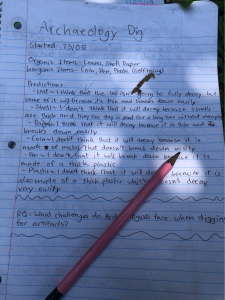 Grade 7 students excitedly sift through the layers of dirt, with previous notes and predictions in hand, and exclaim about what was still there and what wasn’t. Some of the digs even had plants growing from them. Overall Grade 7 had a lot of fun while experiencing on a very small scale, what it’s like to be an archaeologist.
Grade 7 students excitedly sift through the layers of dirt, with previous notes and predictions in hand, and exclaim about what was still there and what wasn’t. Some of the digs even had plants growing from them. Overall Grade 7 had a lot of fun while experiencing on a very small scale, what it’s like to be an archaeologist.
Mrs. Erickson
MYP I&S Teacher
Indonesian Studies Session: “Batik workshop”
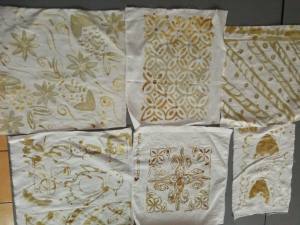
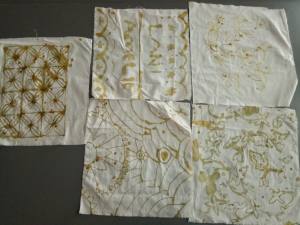
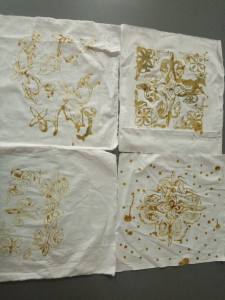
 Kemarin pada hari Kamis, tanggal 24 Oktober, kami belajar tentang cara membuat batik. Membuat batik sangatlah menyenangkan karena batik adalah salah satu kebudayaan asli Indonesia. Yang saya pelajari dari aktivitas kemarin adalah membuat batik itu tidak mudah, perlu waktu untuk membuatnya dengan rapi. Jadi, mari belajar untuk membuat batik!
Kemarin pada hari Kamis, tanggal 24 Oktober, kami belajar tentang cara membuat batik. Membuat batik sangatlah menyenangkan karena batik adalah salah satu kebudayaan asli Indonesia. Yang saya pelajari dari aktivitas kemarin adalah membuat batik itu tidak mudah, perlu waktu untuk membuatnya dengan rapi. Jadi, mari belajar untuk membuat batik!
Adhi Wiguna (grade 9)
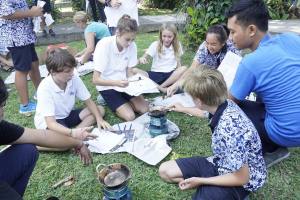 Yesterday on October 24th, secondary students had a batik workshop where we learned how to make batik. During the presentation, I learned that this is a really hard process and each pattern has a deeper cultural meaning. While making my own batik, I realised how challenging it is to make a small pattern. In the end, we should appreciate the people who make clothing with batik design on it.
Yesterday on October 24th, secondary students had a batik workshop where we learned how to make batik. During the presentation, I learned that this is a really hard process and each pattern has a deeper cultural meaning. While making my own batik, I realised how challenging it is to make a small pattern. In the end, we should appreciate the people who make clothing with batik design on it.
Cintya Roby (grade 9)
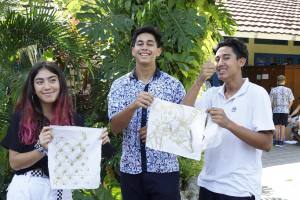 Yesterday’s batik workshop was a great team bonding and new experience for me. I found learning about the origin and the different types of batik fascinating. I was excited when we got to draw our patterns and use the equipments to make our batik. The process was harder than expected but it made me appreciate the people that makes batik and batik itself.
Yesterday’s batik workshop was a great team bonding and new experience for me. I found learning about the origin and the different types of batik fascinating. I was excited when we got to draw our patterns and use the equipments to make our batik. The process was harder than expected but it made me appreciate the people that makes batik and batik itself.
CAS Corner by Laura Salans

Identify own strengths and develop areas for growth
Daisy was one of my most difficult and longest rescues. Her rescue journey began in November of 2018. Because Daisy was one my first severe case and I generally rescue cats, many challenges arose. I believe that one of my strengths during her rescue journey was my ability to adapt to new situations and challenges. For example, when I first tried to capture her she was very timid and clearly traumatized. Instead of giving up, I gained her trust over a week by daily feedings and created a trap using a cage to lure her out. Another strength of mine was my determination to help Daisy and my perseverance in the face of complications. For example, when I was no longer able to house Daisy and she was left to be on the streets, I didn’t give up and started searching for alternate options such as boarding kennels or fosters.
A big weakness of mine during Daisy’s rescue journey was money management. Throughout the three months of her rescue I struggled to keep up with her vet and boarding bills. This led to me having to borrow money and find alternate sources of money. Because of my poor financial management, it affected both me and Daisy. At times I struggled to make meet ends or buy lunch. Another weakness of mine was my inability to separate personal feelings with my rescue. Although this may not seem like a weakness, It is very important with rescues that the rescuer does not get too attached as their personal feelings may interfere with the wellbeing or journey of the rescue. I felt that throughout Daisy’s rescue I became very attached and allowed my personal feelings to hinder the rescue process. For example, I sometimes held back from allowing potential adopters to adopt Daisy. However, Daisy’s case has been a very important learning experience and has made me a better and smarter rescuer.
Demonstrate the skills and recognize the benefits of working collaboratively
Daisy’s rescue and rehabilitation could not have been possible without the help of working collaboratively. I struggled for two months to find Daisy an adopter. However, after months of struggling I decided to work together with a well-known organization called Act4BaliDogs to help find Daisy a home. They helped to promote Daisy’s adoption through their various social media platforms. By working collaboratively, I was able to reach a larger audience and find Daisy the perfect home. Another benefit of working collaboratively is the decreased stress and shared financial burden. As mentioned previously, I struggled to keep up with the costs of Daisy’s rescue but by reaching out to other organizations and working together with them, I was able to lessen the financial burden. The organizations were able to provide me with a bunch of supplies and help to pay part of Daisy’s bills. During Daisy’s rescue I have learned that one of the skills required when working collaboratively is flexibility. For example, I had to be flexible with Daisy’s sterilization date as the Bali Bandana Project office was sometimes closed and busy.
Demonstrate that challenges have been undertaken, developing new skills in the process
The biggest challenge of Daisy’s case was gaining sufficient finance. Because she was unable to find any fosters, she had to be boarded at a vet for two months. On top of the boarding bills, her severe skin issues racked up a very large vet bill and she had to be fed a good quality diet
which was quite expensive. Let’s not forget the bills for other supplies such as collars, blankets, cages, food bowls and etc. As Bali Pet Guardians is still a small and unknown organization, we had little to no funds to help pay off Daisy’s outstanding bills. This led to me having to borrow money from family members and using my personal funds. Once my vet bill reached 10 million rupiah, I realized that I needed to reach out for help If I were to successfully rehabilitate daisy. I reached out to two organizations via Instagram, Act4BaliDogs and the Bali Bandana Project. I explained to them the situation and they helped with donating supplies, paying Daisy’s sterilization bill and eventually finding her a new home. This was a very big achievement for me as I am usually very hesitant to ask for help and like doing things alone. This experience has helped me develop new communication and collaboration skills and has taught me to be more open to help from others.
Show commitment to and perseverance in CAS experiences
I have shown commitment and perseverance in CAS experiences as Daisy is one of my many rescues. I showed perseverance throughout Daisy’s rescue journey because I didn’t give up when things got difficult or I faced issues. I continued to overcome the challenges I faced until Daisy was completely healed and found a new forever home. I will continue to rescue and help more animals like Daisy in the future.
Demonstrate engagement with issues of global significance
I demonstrated engagement with issues of global significance because animal neglect is a global issue. In many third-world countries like Indonesia, animals are not protected by law and are treated as objects or toys. I engaged with the issue of animal neglect by helping Daisy, a neglected dog, have a second chance at life.
Recognize and consider the ethics of choices and actions
Throughout Daisy’s rescue journey I had to constantly think about the ethics of my choices and actions to ensure that Daisy’s health and wellbeing was always ensured and put first. For example, during her capture I had to ensure to keep the pain and trauma to a minimum by using humane capture methods such as luring her out with food and using a loose noose.

